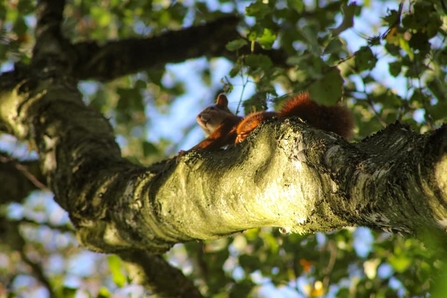September is the time of year where the natural world seems to teeter on the edge of change, with summer migrant birds getting restless and preparing to return to their wintering grounds, and a new, earthy smell of decay distilling into the air. It’s a wonderful time to get outside and soak up the wonders of nature, and our nature reserves in Lancashire, Greater Manchester and North Merseyside are some of the best places to do it.
Latest wildlife sightings – September 2021

Red squirrel at Mere Sands Wood by Katie Cousins
Mere Sands Wood
We couldn’t talk about our September wildlife sightings without mentioning Mere Sands Wood. Last month, lucky visitor Katie spotted perhaps the most exciting creature to have visited one of our nature reserves this whole year – a red squirrel. Katie’s sighting was the first sighting of a red squirrel at Mere Sands Wood since 2017, so our Red Squirrel Project team is now stepping up their monitoring of the area to make sure that we can help these reds cling on.
Brockholes
Brockholes is always one of the best places to spot insects in summer, with butterflies a-plenty on the wing in September, including speckled wood, peacock, red admiral, small copper and common blue. Male and female migrant hawker dragonflies rested on the vegetation whilst common darters guarded fence posts and patrolled the footpaths. But despite the air thrumming with these summer favourites, there was a distinctly autumn flavour in the air. Barn owls started showing well again on their evening hunting trips, jays flew to and fro as they foraged for acorns, and the hawthorn tunnel was painted red with berries that will soon attract throngs of hungry redwings.
Wildfowl and wading birds started to arrive in larger numbers, with a snipe influx numbering more than 35 birds! The in focus team noticed Number One Pit, in front of their shop in The Lookout, getting particularly busy, with growing numbers of shovelers, teal, tufted ducks and gadwall busying themselves on the water.
Excitingly, there was news that two pairs of willow tits have bred down-river of Brockholes. These lovely little birds have declined hugely and are officially the second-fastest declining bird in the UK, after the turtle dove. It’s fantastic to have them breeding so close to one of our nature reserves and we really hope they develop another local stronghold here, adding to our thriving population at Wigan Flashes.
Chat Moss
There is always something to see on our peatlands. Last month, a red-necked phalarope dropped into Little Woolden Moss on-passage to its wintering grounds in the Arctic tundra, and a southern hawker dragonfly was spotted ovipositing in the peat! Watch it in action in the video, above, captured by Dave Steel.
Volunteers also found some palmate newt babies at Little Woolden Moss – the first time these amphibians have been recorded on this reserve.
Over on Astley Moss, we recorded a female black darter dragonfly (distinguishable from the mostly black males by their ochre-coloured abdomens), and the weird and wonderful dog vomit slim mould. This incredible fungus is also known as scrambled egg slime mould and is actually more closely related to amoebas than fungi. Fun fact - slime moulds can solve mazes!
Upper Coldwell Reservoir
September means a grass-of-Parnassus count at our Upper Coldwell Reservoir nature reserve in Lancashire. Staff and volunteers count these rare plants each year, with our count for 2021 totalling 447 flower-buds, flower-heads and seed-heads. This is slightly up on last year but way down on previous years, which is possibly due to the grassland not being cut since 2018. We’ll now cut and rake the area in early November to see if this boosts the grass-of-Parnassus population again.

Roe deer at Middleton Nature Reserve by Janet Packham
Middleton Nature Reserve
The birds obviously hadn’t got the message about the No Swimming Pond, because it filled with ducks last month. Gadwall, wigeon, little grebes, snipe and teal were all recorded on the water, while volunteers spotted a green sandpiper on the Tim Butler Pond and a very vocal Cetti’s warbler around the Main Pond.
It was wonderful to see a tree sparrow on the reserve, while Janet Packham captured the lovely picture, above, of a roe deer in the vegetation. There were some beautiful species in the moth trap, including:
- Sallow
- Bulrush wainscot
- Flounced rustic
- Lesser yellow underwing
- Silky wainscot
- Brown China mark
Heysham harbour
The number of waders feeding and roosting at Heysham harbour only continued to grow last month – a sure sign that autumn is settling in. Top counts included:
- 2,000 knot
- 100 grey plovers
- 100 bar-tailed godwits
- 1,000 dunlin
- 100 curlew
- 500 oystercatchers
- 1 greenshank
- 30+ lapwings
- 50 redshank
- 30 turnstones
- 25 ringed plovers
And that wasn’t all. In September we also recorded sandwich terns on Red Nab, white wagtails scampering along the shore and linnets feeding on the saltmarsh. Three chiffchaffs were recorded near the waterfall area, no doubt thinking about their long migration back to Africa.
Some of the more exciting September sightings included the first autumn records of whinchats and stonechats at Heysham Head, grey seals dozing in the harbour mouth, and a drake scaup out at sea.
Heysham Moss
Heysham Moss was a great place to spot dragonflies in September, with nine black darters recorded across this precious peatland nature reserve. Volunteers also spotted a migrant hawker dragonfly as well as countless common darters, including nine ovipositing at the same time in the same area!
Have you spotted something cool at our nature reserves recently? Or even something beautifully ‘every day’? We’d love to hear all about it – click one of the icons below to share your sightings with us on social media.

